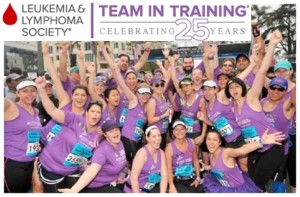
Celebrating 25 Years and Counting: Leukemia and Lymphoma Society’s “Team In Training” Goes the Distance and Beyond for Blood Cancer Patients www.teamintraining.org. We speak to Coach Kelly Flynn.
WHITE PLAINS, N.Y., June 19, 2013 /PRNewswire/ — This year alone, The Leukemia & Lymphoma Society (LLS) is supporting more than 300 research projects with one goal in mind: Discovering lifesaving therapies for blood cancer patients. And in 2013, “Team In Training” (TNT), a flagship LLS fundraising campaign and the world’s first and largest endurance sports training program, is marking its landmark 25th anniversary. To date, TNT has helped LLS invest more than $875 million in research to discover and deliver breakthrough cancer treatments that are saving lives today.
“More than 570,000 participants have participated in Team In Training since 1988. Not only have they had an unforgettable experience and opportunity to reach personal goals, but these committed individuals have brought us closer to the ultimate finish line: The end of blood cancers,” states George Omiros, Executive Vice President, Chief Campaign and Field Development Officer, LLS. “Team In Training has played a tremendous role in the success of LLS, in helping us fund leading scientists and researchers to discover novel, breakthrough blood cancer treatments and cures.”
In fact, advances achieved partly through LLS-funded research have increased the five-year survival rate for acute lymphocytic leukemia (ALL) from three percent in 1964 to 90 percent today. Further, blood cancer research is a gateway to treatments and even cures for many other cancers, as well as some inflammatory diseases, such as rheumatoid arthritis. “Thanks to extraordinary campaigns such as Team In Training, LLS is able to fund breakthrough therapies that are saving lives today,” states Louis DeGennaro, PhD, Chief Mission Officer, LLS. “For example, LLS funding helped advance the discovery and clinical testing of Gleevec® which has transformed chronic myeloid leukemia (CML) from an almost always fatal disease into a chronic manageable condition for most CML patients.”

